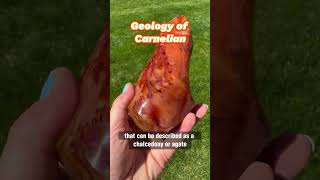Learn about the geology of Carnelian! #crystals #minerals #geology #carnelian #smallbusiness
Learn about the geology of Carnelian! #crystals #minerals #geology #carnelian #smallbusiness

Carnelian is found all over the world including India, Brazil, USA, Egypt, Madagascar, Botswana, and Uruguay. In fact, Carnelian has been mined in India and Egypt for over 5,000 years. It is believed that the finest pieces of Carnelian are found in India, but pure examples of Carnelian appear worldwide. Carnelian is a red or reddish-orange form of chalcedony. It can form as one color or can have strong bands. It appears in various shades that range from pale, pinkish-orange, to a deep, rust-brown of red. Carnelian’s color comes from the presence of Iron Oxide. Carnelian ranges from translucent to opaque and has a waxy luster.
Carnelian is a type of microcrystalline quartz that can be described as Chalcedony or Agate. Carnelian is formed when silica rich material, including quartz and moganite, from volcanic eruption becomes trapped in different cavities in rock and cools. Over time, different layers of the silica rich material may cool over the previous ones. This creates the banding we see in some types of carnelian, because each layer may have a different amount of iron-oxide, giving each layer its own shade of red or orange. If your Carnelian has these different colored layers, then it is considered an Agate. If your Carnelian is one uniform color, it is better described as Chalcedony.
Carnelian is usually mined in surface mines and is found relatively shallow in the earth. First, a layer of materials must be removed to reveal the carnelian. This carnelian will be attached to other materials and will be separated once it is pulled from the earth. In some locations, especially in the United States, carnelian can be removed by hand relatively easily and in some places, along the Nehalem River in Oregon or streams in Stirling, New Jersey, this is a fun tourist attraction.
On the Mohs scale of mineral hardness Carnelian grades at a 6.5 to 7. It is a relatively smooth crystal and has no cleavage, meaning it does not split evenly.
#geology #minerals #crystals #geologyrocks #geologist #rocks #mineral #rockhound #gemstones #geologypage #gems #mineralporn #gemstone #mineralspecimen #mineralogy #crystalhealing #gemology #mineralsforsale
